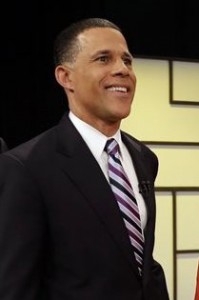
Lt. Gov. Anthony Brown. (AP Photo)
With less than a week before the June 24 primary elections, polls from two different news agencies show Lt. Gov. Anthony Brown with a commanding lead over his two principal opponents, Attorney General Doug Gansler and Delegate Heather Mizeur. As the final day approaches a significant percentage of voters remain apathetic, registering no opinion regarding the candidate they support.
Among likely voters, a Washington Post poll published June 10 found that 46 percent would vote for Brown were the election held that day (the poll was conducted from June 5-8). Gansler trailed behind, garnering only 23 percent of likely voters polled. Mizeur came in third, with 16 percent.
The poll also found that four percent of voters did not intend to vote for any of the three leading candidates, while 12 percent had formed no opinion between the three. Brown’s 23 percent lead over the second place Gansler dwarfs the combined 16 percent of those who have so far not committed to any of the candidates, suggesting Brown’s lead is safe.
A poll conducted by the Baltimore Sun from May 31 to June 3, found that Brown had a 21 point edge over Gansler, with Brown receiving 41 percent of likely voters to Gansler’s 20.
On June 11, the Washington Post published the result of their poll on the Attorney General’s race in Maryland. Delegate Jon Cardin led Sen. Brian Frosh, 26 percent to 20, while Aisha Braveboy had 13 percent support. That poll also found, however, that 31 percent of likely voters had formed no opinion on any of the three leading candidates, meaning that this race is still very much up for grabs, and could easily be shifted by one of the campaigns with an effective get-out-the-vote operation.

Early Voting Maryland. (AP Photo)
An additional 9 percent of likely voters polled said they would not vote for any of the three. As of 2 p.m. on the fifth day of early voting (June 16), 4,965 votes had been cast so far in Baltimore City in the 2014 primary election according to Hanan Fleming, an
administrative assistant with the Baltimore City Board of Elections. Because votes are not counted until after the primary on June 24, no data is available regarding the division of those votes among the candidates.
In the 2010 primary, a total six days of early voting yielded 7,244 votes in Baltimore City, according to data available on the Baltimore City Board of Elections website. The 2012 primary, held during a presidential election year, saw a similar if slightly higher 7,508 early votes cast in Baltimore City over the six day early voting period.
Based on the figures available so far, Baltimore City will need over 2,000 votes on the sixth and final day of early voting to match either of the previous two totals. The 2010 and 2012 primary elections saw 1,640 and 1,656 early votes tallied on the sixth and final day of early voting respectively, suggesting this year’s numbers are off the pace of the previous two primary elections.
In the Republican primary for governor, the same Baltimore Sun poll that had Brown ahead by 21 points found that candidate Larry Hogan leads with 27 percent of likely voters backing him, while his two nearest opponents, David Craig and Charles Lollar, trail behind with 12 percent each. A full 37 percent of likely voters said they were undecided as to any of the Republican candidates.
ralejandro@afro.com.


